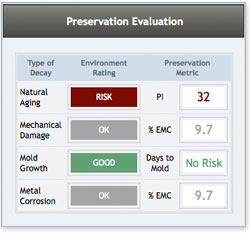How to Use: Step 2 — Preservation Evaluation
Guide to Environmental Ratings used by the Dew Point Calculator: |
Natural Aging
TWPI Value (years) |
Interpretation |
≥75 |
|
45 ≤ and < 75 |
|
< 45 |
|
Mechanical Damage
% EMC |
Interpretation |
≥ 5 AND ≤ 12.5 |
|
≤ 4.9 OR ≥ 12.6 |
|
NOTE: On the Dew Point Calculator, there is no "Good" rating for Mechanical Damage
Mold Risk
Days to Mold |
Interpretation |
No Risk |
|
> 1 day to mold |
|
Metal Corrosion
% EMC |
Interpretation |
< 7.0 |
|
7.1 ≤ and < 10.5 |
|
≥ 10.5 |
|
|
|
|
The DP Calculator Preservation Evaluation is based on IPI’s Preservation Metrics™ which were developed to transform temperature and relative humidity data into quantitative numerical measures of material decay risk.
 Each combination of T, RH and DP determines the environmental rating for four major forms of material decay—natural aging or chemical decay, mechanical damage or dimensional change, mold risk, and metal corrosion.
Each combination of T, RH and DP determines the environmental rating for four major forms of material decay—natural aging or chemical decay, mechanical damage or dimensional change, mold risk, and metal corrosion.
Note that these ratings evaluate a static condition and don’t take change over time into consideration. The Environmental Ratings and Preservation Metrics would vary if you were evaluating data collected over a period of time.
PI = Preservation Index
PI represents the overall rate of chemical decay in organic materials based on a constant T and RH. A higher number indicates a slower the rate of chemical decay. (IPI developed the Time-Weighted Preservation Index, or TWPI, to illustrate chemical decay as the environment changes over time.)
%EMC = % Equilibrium Moisture Content
Hygroscopic (water-absorbing) materials change size and shape depending on the amount of water they contain. These physical reactions are based on the amount of moisture in the air (RH). Maximum %EMC (≤ 12.5%) indicates a damp environment while Minimum %EMC (≤ 5%) identifies a dry environment. These conditions, as well as wide and/or frequent fluctuations can result in mechanical damage.
MRF = Mold Risk Factor
The MRF represents the risk of mold germination and subsequent growth. A value of 0.5 or less indicates an environment with little or no risk of biological decay. 0.5 indicates that mold spores are half way to germination. In a real-life situation the environment would be evaluated over time to create a running sum of progress toward mold germination.
 Each combination of T, RH and DP determines the environmental rating for four major forms of material decay—natural aging or chemical decay, mechanical damage or dimensional change, mold risk, and metal corrosion.
Each combination of T, RH and DP determines the environmental rating for four major forms of material decay—natural aging or chemical decay, mechanical damage or dimensional change, mold risk, and metal corrosion.





